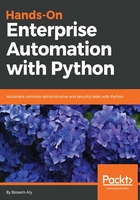
Conventions used
There are a number of text conventions used throughout this book.
CodeInText: Indicates code words in text, database table names, folder names, filenames, file extensions, pathnames, dummy URLs, user input, and Twitter handles. Here is an example: "Some large packages such as matplotlib or django have hundreds of modules inside them, and developers usually categorize the related modules into a sub-directories."
A block of code is set as follows:
from netmiko import ConnectHandler
from devices import R1,SW1,SW2,SW3,SW4
nodes = [R1,SW1,SW2,SW3,SW4]
for device in nodes:
net_connect = ConnectHandler(**device)
output = net_connect.send_command("show run")
print output
When we wish to draw your attention to a particular part of a code block, the relevant lines or items are set in bold:
hostname {{hostname}}
Any command-line input or output is written as follows:
pip install jinja2
Bold: Indicates a new term, an important word, or words that you see onscreen. For example, words in menus or dialog boxes appear in the text like this. Here is an example:
"Choose your platform from the Download page, and either the x86 or x64 version."
Warnings or important notes appear like this.
Tips and tricks appear like this.